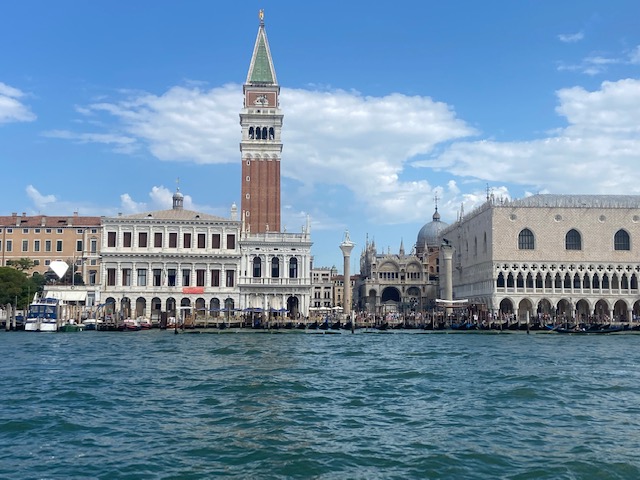

The top of the Campanile di San Marco is, literally and figuratively, the coolest spot in Venice.
It was about 3 o’clock on a July afternoon when I managed to, for a moment, sit down in a sliver of shade on the two steps lining the interior boundary of Venice’s Piazza San Marco. Humid air hung in the crowded, paved expanse of Saint Mark’s Square under hot, high-sky sunshine. But not in my prized little slice, where I sat with my legs crossed watching a long line of people, some with parasols, waiting to get into the unairconditioned Basilica San Marco.
“Nessuna seduta! No sitting, please,” the female official said firmly. I looked up to realize she was talking to me. I don’t know if she was carabinieri or not, but she was uniformed, and I could tell she meant business, so I rose to get onto my feet.
“Si, si. Lo so, lo so,” I blurted out as I wobbled up.
The wobbling, I assure you, was not from the requisite, 22-Euro, little Bellini I’d drank at Harry’s Bar.
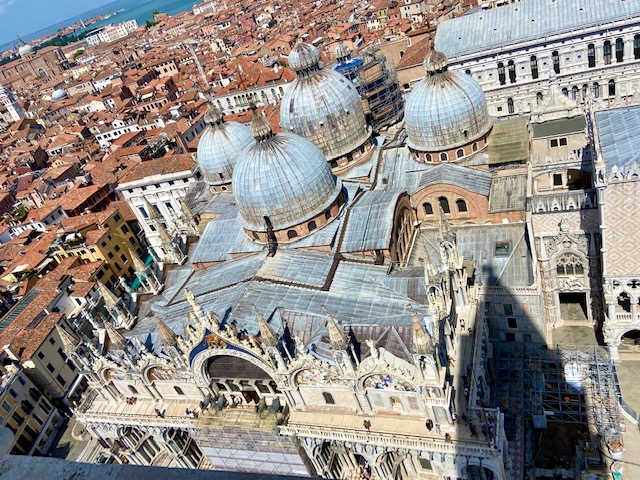
Harry’s Bar
Harry’s Bar, the virtually unmarked, but historically significant, Hemingway hangout where the Bellini was invented, is across San Marco piazza past the Royal Gardens on a corner across from the San Marco vaporetto dock. When walking off of the vaporetto dock, Harry’s is easy to find. From elsewhere, not so much. The brick building has minimal signage except on the little windows and the swinging half doors on the side street entrance.
Unlike the rest of ornate Venice, understated Harry’s Bar, with muted yellow walls and mahogany bar, is simple in style.
“Our tour company told us we’d never find it,” I heard an American from Alabama seated at the bar with her husband, say.
Harry’s has a handful of tables along its tiny perimeter, so they prefer guests to sit at the bar unless they plan to order food. The Bellinis aren’t big, so I savored mine, and the atmosphere, and the little dish of olives I was given, at the far corner of the bar opposite the door. From there I watched a tennis-shoed tourist couple with two young adults clamor in and each get a Bellini. They sat at the bar next to the door, barely in the room.
“Okay, drink ‘em,” the father instructed. Within five minutes, map in hand, they were gone. I suppose they needed to check Harry’s off their “to see” list before running to the next spot, but at 22 Euro each, they’d dropped $100 in five minutes.
This prospect prompted me to ask the white-coated, black-tied barman how many of the fresh Bellinis he squeezes out in a day.
“Oofa,” he reacted. “A million!”

Things Were Looking Up
As I stood in my sliver of shade, it had been a while since my visit to Harry’s, so I was thirsty. I’d discovered the cafes inside St. Mark Square, such as Florian, serve a small bottle of Coke Zero (standard diet Coke you will not find) for 10 Euro…and a bottle of water is just under that. Fanciful gelato treats are 18 Euro. These prices made Harry’s Bellini seem like a bargain!
But I was about to discover the best value in Venice as I looked up and finally surveyed what was creating my oasis of shade. Over me loomed perhaps the most iconic of Venice’s many architectural features: the Campanile di San Marco – the slender, artistic, pointed, 98-meter, brick bell tower – the spire of St. Mark’s Square.

My policy when traveling in Italy is to never, ever walk past a church, any church not just big-name ones, without looking inside. The surprises and inspiring artwork you’ll discover doesn’t disappoint. I embrace that policy, also, for art and historical elements such as, in this case, the Campanile. With time on my hands, it seemed I was in the right place at the right time. And that guard who insisted I stand up didn’t realize just how far up I would end up.
One might initially dismiss the idea of going to the top as a touristy thing to do. Stories decrying the disappointing St. Louis Arch experience, for instance, are legion. Many cities, Las Vegas, Seattle, Toronto, have observation towers. But would you go to Paris without summiting the Tour Eiffel?
Reach for the Stars
Another of the travel philosophies I’ve learned is to never assume you cannot do something – which I almost did during that moment in the shadow of St. Mark’s Campanile. It was later in the afternoon in the middle of the very busy tourism season, so I supposed all the tickets would either be sold out for the day or that the access line would be very long.
I wondered, too, whether the viewing platform at the top of the 323-foot watchtower, rebuilt in 1912 after collapsing in 1902, was accessible only by stairs? I estimated that to be 25 stories in an enclosed stairwell on a 90-degree day.
I walked around to the entrance, which was still also in the shade. Next to the steps and velvet rope leading up to what was essentially the iconic campanile’s front porch, I saw a sign that read “skip the line reservations.” A security guard stood at the top of the five steps under an umbrella. No one was going up the steps to the ticket window. There were, though, on either side of the steps, people sitting on long cement benches built into the foundation.
Were they in a line awaiting their turn?
Did they have reservations?
Was the campanile closed for the day?
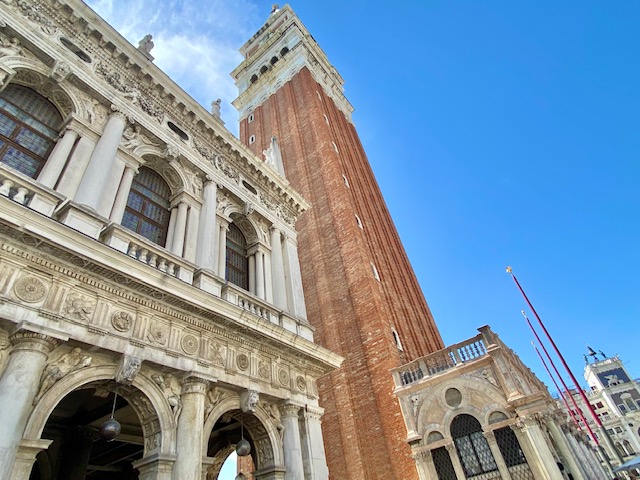
Knock and it Shall Be Opened
I walked up the little steps and, in my “pico Italiano,” approached the guard.
“Buena serra,” I began. “Posso su…casa aperto?”
“I speak English,” the guard halted me, but politely, in his Italian accent.
“Ah, grazie. Is the tower open?”
“Yes, you can go.”
“Did I need a reservation?”
“No. You can walk up there to the window and buy a ticket. 10 Euro.”
So far it was, surprisingly, all green lights.
“Is it stairs only?”
The guard scoffed. “No stairs now. You must go by elevator. Stairs on a day like this…could be dangerous.”
That was, I admit, music to my ears, having already walked about five miles around Venice that day.
So, with no wait at all, I went inside the tower, plopped down 10 Euro, and immediately got on the elevator.
Heaven Above Venice
It took 30 seconds for the windowless, attended elevator, with room for about eight people, to go up the center of the tower from the ground floor to the belfry. I emerged from the elevator and into the two-story, four-sided, covered space to find massive black bells hanging from the ceiling above decorative tiled ballroom flooring.
The cool breeze blowing through the big, thin wire screened, open windows was like a gust from the gods. After steaming in the sun on the sidewalks below (I found very little greenspace in Venice) I was chilling in the clouds at the top of a world-famous icon. It was one of the most pleasant moments of my lifetime.
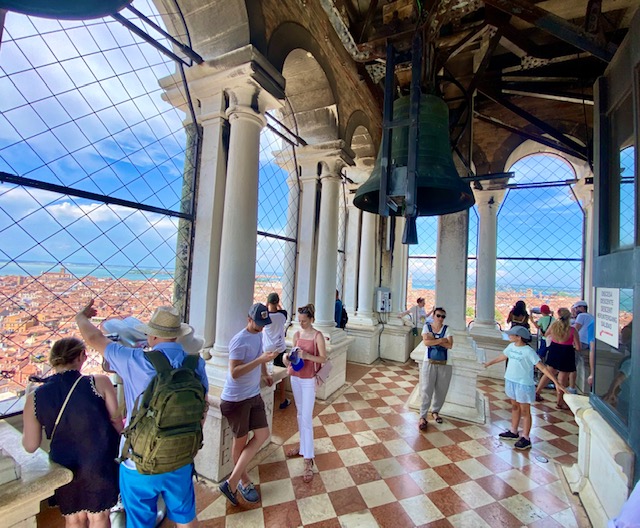
A few of the open windows had high-powered binoculars for viewing – but you didn’t need them – and little display maps to detail what buildings you were seeing in each direction.
The panoramic view of the lagoon, St. Georgio Maggiore, Lido, Murano and Torcello islands was astonishing. Looking down atop the Basilica of St. Mark was surreal. And the view of the dome of Santa Maria della Salute was sweeping.
Otherwise, it’s all red roofs as far as the eye can see. Rialto Bridge, and much of the Grand Canal is not visible as it cuts between the palazzos. Similarly, the campanile is not visible from the labyrinth of streets and canals in other parts of Venice.
People took photos and selfies and were respectful to rotate not to linger too long in the window enclaves, which are wide enough for two or maybe three people to stand in, though it was very natural for cooing couples.
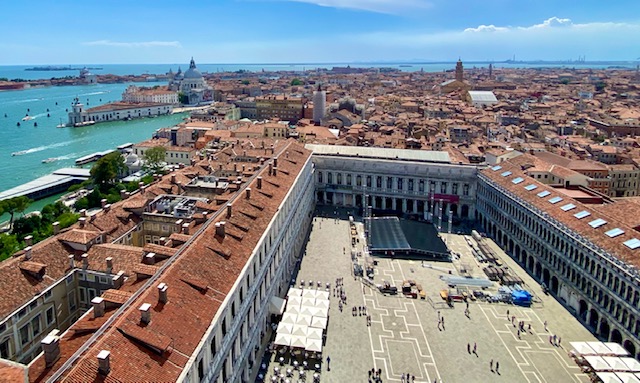
Looking Back
After I took pictures, and a few for others, I made certain to take in every view available from each side of the tower. As I savored the Bellini, I felt the fresh breeze cool my body and dry my linen shirt. Then, in that rarefied air, I decided to breathe a little. I perched myself in a window and gazed in the direction of a certain portion of Venice I had come to treasure: Campo Santi Apostoli.
I couldn’t see the charming, small square but I could survey the general vicinity thanks to the obvious and ornate steeple of the Chiesa dei Santi Apostoli di Cristo – the 7th century Church of the Holy Apostles of Christ rising there. Its spire has a stylish, one-handed, clock face on the side.
The little square is not far from the Rialto Bridge but, being off the Grand Canal, is much less busy and trafficked, other than those passing through toting luggage along Strada Nova to and from the train station or perhaps the hidden Ca d’ Oro Vaporetto dock, which can be found by turning at the unfortunate McDonalds among the shops and restaurants. One can also easily walk to the Casino d’ Venezia that way.
I discovered Campo Santi Apostoli when I wandered out of my Grand Canal hotel, named “Venice, Venice” one evening for a walk. The square, just over a small canal bridge, felt like a secret backyard party to the quiet but vibrant contemporary hotel (that just happens to be built inside Ca da Mosto – one of Venice’s oldest palazzos.)
Descending from the bridge I saw a handbag store, souvenir kiosk, a bakery, a couple of casual restaurants with outdoor dining, and the Gelato di Natura creazioni artigianali shop. Gorgonzola gnocchi followed by gelato were my first-night indulgences in Campo Santi Apostoli, but I returned each evening for long sits on the benches under the green trees and take in the scene, which included people posing for wedding photos on the bridge and children sitting and dangling their feet over the edge of the canal as gondoliers pushed their passengers by.
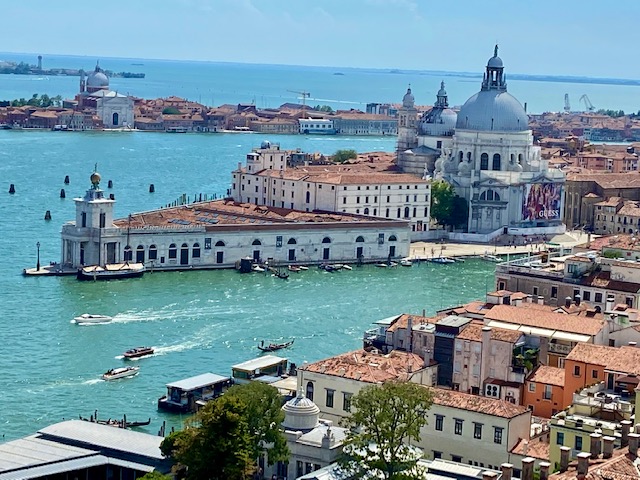
IC Bellagio
IC Bellagio.com, Italy’s premier custom travel planner (IC stands for “Italian Connection,” recommended Venice, Venice Hotel, and I am grateful they did, because it gave me both the Grand Canal position and access to this lovely, lively spot.
Nearer St. Mark’s Square – in which I also sat lingering one evening past midnight – IC Bellagio recommends the Hotel Londra Palace, stately, classical lodging with views which will make you sigh – steps from the Bridge of Sighs.
In turn, I’d like to recommend “Tiro Vino Il Chioschetto,” the little, green kiosk sitting along the edge of Campo Santi Apostoli. The two men serving drinks out the window – in plastic cups if you’re leaving; glassware if you’re standing to enjoy their company – are spirited and funny. Cheeky signs saluting drinking are displayed. My favorite – painted on the glass – read “Take it easy for a little while.”
A Spritz Aperol, Campari or Select was three euro.
“You prefer I charge you more?” the bartender joked when I was surprised.
I guess I was still in shock from the prices at Harry’s and Florian.
He crafted the Spritz in seconds with prosecco out of a gun and an aerator, I think, for extra “spritz.”
Young people all evening clamored around the happy kiosk.
It wasn’t easy to leave that vibe, but I took my Spritz to go and stood on the balcony of the Venice, Venice Hotel’s second-story bar overlooking Rialto Bridge on the Grand Canal and drank it under the stars.
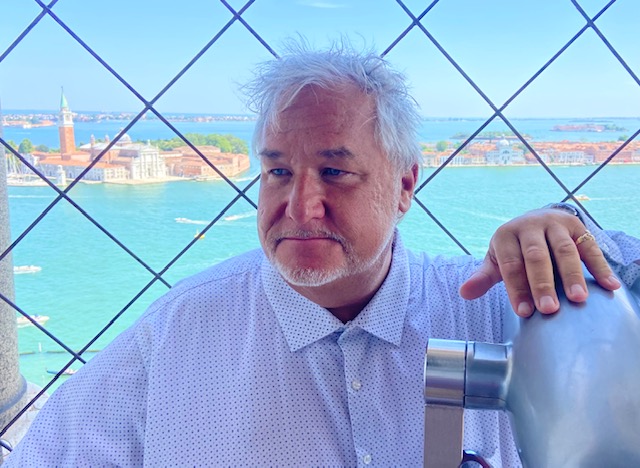
Read more on Michael Patrick Shiels’ travel blog, The Travel Tattler. Contact Travel Writer Michael Patrick Shiels at [email protected]
- e.baldi is Beverly Hills Best Italian Dining Delicacy - April 23, 2024
- Ashford Castle Hotel, U2’s Bono and Why Visting Ireland is So Entertaining - March 28, 2024
- Solo Travel to Oceania Cruise Ports St. Barth’s and Barbados Became Authentic Cultural Encounters - February 27, 2024
